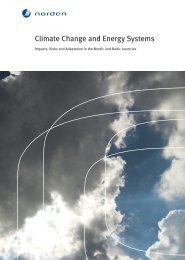estimating total power consumption by servers in the us and the world
estimating total power consumption by servers in the us and the world
estimating total power consumption by servers in the us and the world
- No tags were found...
You also want an ePaper? Increase the reach of your titles
YUMPU automatically turns print PDFs into web optimized ePapers that Google loves.
ESTIMATING TOTAL POWER CONSUMPTION BY SERVERS INTHE U.S. AND THE WORLDJonathan G. Koomey, Ph.D.Staff Scientist, Lawrence Berkeley National Laboratory <strong>and</strong>Consult<strong>in</strong>g Professor, Stanford UniversityContact: JGKoomey@stanford.edu, http://www.koomey.comF<strong>in</strong>al reportFebruary 15, 2007
EXECUTIVE SUMMARYThe amount of electricity <strong>us</strong>ed <strong>by</strong> <strong>servers</strong> <strong>and</strong> o<strong>the</strong>r Internet <strong>in</strong>frastructure has become animportant issue <strong>in</strong> recent years as dem<strong>and</strong>s for new Internet services (like m<strong>us</strong>icdownloads, video-on-dem<strong>and</strong>, <strong>and</strong> Internet telephony) have become more widespread.One of <strong>the</strong> weaknesses <strong>in</strong> <strong>the</strong> literature on data center electricity <strong>us</strong>e has been <strong>the</strong> lack ofcredible estimates of <strong>the</strong> aggregate <strong>power</strong> <strong>us</strong>ed <strong>by</strong> all <strong>servers</strong> <strong>and</strong> associated equipment <strong>in</strong><strong>the</strong> U.S. <strong>and</strong> <strong>the</strong> <strong>world</strong>. The data on <strong>the</strong> floor area <strong>and</strong> <strong>power</strong> densities of data centers areanecdotal <strong>and</strong> limited <strong>by</strong> <strong>the</strong> proprietary nature of such data <strong>in</strong> most companies. Data on<strong>the</strong> <strong>in</strong>stalled base of <strong>servers</strong> are also closely held <strong>by</strong> <strong>the</strong> companies who track it, <strong>and</strong>server technology cont<strong>in</strong>ues to change rapidly, necessitat<strong>in</strong>g constant updates tomeasurements of <strong>power</strong> <strong>us</strong>ed <strong>by</strong> particular server models.This study estimates <strong>total</strong> electricity <strong>us</strong>ed <strong>by</strong> <strong>servers</strong> <strong>in</strong> <strong>the</strong> U.S. <strong>and</strong> <strong>the</strong> <strong>world</strong> <strong>by</strong>comb<strong>in</strong><strong>in</strong>g measured data <strong>and</strong> estimates of <strong>power</strong> <strong>us</strong>ed <strong>by</strong> <strong>the</strong> most popular <strong>servers</strong> withdata on <strong>the</strong> server <strong>in</strong>stalled base. These estimates are based on more detailed data thanare previo<strong>us</strong> assessments, <strong>and</strong> <strong>the</strong>y will be of <strong>us</strong>e to policy makers <strong>and</strong> b<strong>us</strong><strong>in</strong>essesattempt<strong>in</strong>g to make sense of recent trends <strong>in</strong> this <strong>in</strong>d<strong>us</strong>try.Aggregate electricity <strong>us</strong>e for <strong>servers</strong> doubled over <strong>the</strong> period 2000 to 2005 both <strong>in</strong> <strong>the</strong>U.S. <strong>and</strong> <strong>world</strong>wide (Figure ES-1). Almost all of this growth was <strong>the</strong> result of growth <strong>in</strong><strong>the</strong> number of <strong>the</strong> least expensive <strong>servers</strong>, with only a small part of that growth be<strong>in</strong>gattributable to growth <strong>in</strong> <strong>the</strong> <strong>power</strong> <strong>us</strong>e per unit.Total <strong>power</strong> <strong>us</strong>ed <strong>by</strong> <strong>servers</strong> represented about 0.6% of <strong>total</strong> U.S. electricity <strong>consumption</strong><strong>in</strong> 2005. When cool<strong>in</strong>g <strong>and</strong> auxiliary <strong>in</strong>frastructure are <strong>in</strong>cluded, that number grows to1.2%, an amount comparable to that for color televisions. The <strong>total</strong> <strong>power</strong> dem<strong>and</strong> <strong>in</strong>2005 (<strong>in</strong>clud<strong>in</strong>g associated <strong>in</strong>frastructure) is equivalent (<strong>in</strong> capacity terms) to about five1000 MW <strong>power</strong> plants for <strong>the</strong> U.S. <strong>and</strong> 14 such plants for <strong>the</strong> <strong>world</strong>. The <strong>total</strong> electricitybill for operat<strong>in</strong>g those <strong>servers</strong> <strong>and</strong> associated <strong>in</strong>frastructure <strong>in</strong> 2005 was about $2.7 B<strong>and</strong> $7.2 B for <strong>the</strong> U.S. <strong>and</strong> <strong>the</strong> <strong>world</strong>, respectively.This study only assesses <strong>the</strong> direct electricity <strong>us</strong>ed <strong>by</strong> <strong>servers</strong> <strong>and</strong> associated<strong>in</strong>frastructure equipment. It does not attempt to estimate <strong>the</strong> effect of structural changes<strong>in</strong> <strong>the</strong> economy enabled <strong>by</strong> <strong>in</strong>creased <strong>us</strong>e of <strong>in</strong>formation technology, which <strong>in</strong> many casescan be substantial.i
Figure ES-1: Total electricity <strong>us</strong>e for <strong>servers</strong> <strong>in</strong> <strong>the</strong> U.S. <strong>and</strong> <strong>the</strong> <strong>world</strong> <strong>in</strong> 2000 <strong>and</strong>2005, <strong>in</strong>clud<strong>in</strong>g <strong>the</strong> associated cool<strong>in</strong>g <strong>and</strong> auxiliary equipmentii
ESTIMATING TOTAL POWER CONSUMPTION BY SERVERS INTHE U.S. AND THE WORLDINTRODUCTIONJonathan G. Koomey, Ph.D.Staff Scientist, Lawrence Berkeley National Laboratory <strong>and</strong>Consult<strong>in</strong>g Professor, Stanford UniversityElectricity <strong>us</strong>ed <strong>by</strong> <strong>in</strong>formation technology (IT) equipment has been a subject of <strong>in</strong>tense<strong>in</strong>terest s<strong>in</strong>ce <strong>the</strong> first ENERGY STAR specification for personal computers was released <strong>in</strong><strong>the</strong> early 1990s (Johnson <strong>and</strong> Zoi 1992). The first detailed measurements of personalcomputer electricity <strong>us</strong>e were published <strong>in</strong> <strong>the</strong> late 1980s (Harris et al. 1988) followed <strong>by</strong>estimates of <strong>total</strong> <strong>power</strong> <strong>us</strong>ed <strong>by</strong> office equipment (Koomey et al. 1996, Norford et al.1990, Piette et al. 1991) <strong>and</strong> assessments of potential efficiency improvements <strong>in</strong> thatequipment (Ledbetter <strong>and</strong> Smith 1993, Lov<strong>in</strong>s <strong>and</strong> Heede 1990).As <strong>the</strong> 1990s came to a close, it was becom<strong>in</strong>g clear that a new class of IT equipment was<strong>in</strong>creas<strong>in</strong>g <strong>in</strong> importance. Computer <strong>servers</strong>, <strong>and</strong> <strong>the</strong> data center facilities <strong>in</strong> which <strong>the</strong>ywere located, were becom<strong>in</strong>g more numero<strong>us</strong> <strong>and</strong> more electricity <strong>in</strong>tensive. The firstmajor efforts to underst<strong>and</strong> server electricity <strong>us</strong>e more deeply were spurred <strong>by</strong> acontroversy over <strong>the</strong> <strong>total</strong> <strong>power</strong> <strong>us</strong>ed <strong>by</strong> IT equipment <strong>in</strong> which dubio<strong>us</strong> claims weremade about <strong>the</strong> contribution of IT equipment to <strong>total</strong> electricity <strong>us</strong>e <strong>in</strong> <strong>the</strong> U.S. (Huber<strong>and</strong> Mills 1999, Mills 1999). These claims were subsequently refuted (Baer et al. 2002,Kawamoto et al. 2002, Koomey et al. 2002, Koomey et al. 2004, Koomey et al. 1999,Roth et al. 2002) but out of <strong>the</strong> controversy grew <strong>the</strong> first peer-reviewed measurements ofdata center electricity <strong>us</strong>e (Blazek et al. 2004, Mitchell-Jackson et al. 2002, Mitchell-Jackson et al. 2003). Later studies built upon that earlier work to created detailedmeasurements of data center <strong>power</strong> <strong>us</strong>e <strong>in</strong> multiple facilities (Greenberg et al. 2006,Tschudi et al. 2004, Tschudi et al. 2006, Tschudi et al. 2003).Recent growth <strong>in</strong> <strong>the</strong> Internet <strong>in</strong>d<strong>us</strong>try has led <strong>the</strong> popular press to report on <strong>in</strong>creas<strong>in</strong>gdem<strong>and</strong>s for <strong>power</strong> from data centers (Delaney <strong>and</strong> Smith 2006, Markoff <strong>and</strong> Hansell2006), but <strong>the</strong>se reports are anecdotal <strong>and</strong> may not reflect aggregate trends. Reports oflarge dem<strong>and</strong> growth have also prompted <strong>in</strong>terest from <strong>the</strong> policy community <strong>in</strong>promot<strong>in</strong>g higher efficiency <strong>in</strong> <strong>the</strong>se facilities (Loper <strong>and</strong> Parr 2007). The purpose of thisstudy is to accurately characterize electricity <strong>us</strong>ed <strong>by</strong> <strong>servers</strong> <strong>in</strong> <strong>the</strong> U.S. <strong>and</strong> <strong>the</strong> <strong>world</strong> sothat public debate can proceed based on accurate data <strong>in</strong>stead of <strong>the</strong> speculation <strong>and</strong>hearsay that so often runs rampant <strong>in</strong> disc<strong>us</strong>sions of such topics (Koomey 2003, Koomeyet al. 2002).PREVIOUS WORKSeveral peer-reviewed estimates of <strong>power</strong> <strong>us</strong>ed <strong>by</strong> <strong>servers</strong> <strong>and</strong> data centers werecompleted around <strong>the</strong> year 2000 (Kawamoto et al. 2001, Mitchell-Jackson et al. 2002,1
Roth et al. 2002). The most detailed <strong>and</strong> comprehensive of <strong>the</strong>se was that <strong>by</strong> Roth et al.(2002), which <strong>us</strong>ed aggregate data from IDC (http://www.idc.com) <strong>by</strong> server class <strong>and</strong>measured <strong>power</strong> data on a representative server for each class. The study also assessed<strong>the</strong> electricity <strong>us</strong>ed <strong>by</strong> data storage (tape <strong>and</strong> hard disk drive) systems <strong>and</strong> networkequipment.Unfortunately, little recent peer-reviewed work has been completed <strong>in</strong> this area. Oneexception was an extension of <strong>the</strong> Roth et al. analysis to 2004 completed <strong>by</strong> Ton <strong>and</strong>Fortenbery (2005) as part of <strong>the</strong>ir work on server <strong>power</strong> supplies. This work <strong>us</strong>ed <strong>the</strong>same analytical structure as Roth et al. but updated <strong>the</strong> <strong>in</strong>stalled base <strong>and</strong> <strong>power</strong> <strong>us</strong>e perunit estimates to reflect more recent data.This analysis improves on <strong>the</strong> Roth et al. analysis for <strong>servers</strong> <strong>by</strong> <strong>estimat<strong>in</strong>g</strong> <strong>power</strong> <strong>us</strong>e for<strong>servers</strong> <strong>in</strong> 2000, 2003, 2004, <strong>and</strong> 2005, <strong>and</strong> <strong>by</strong> <strong>us</strong><strong>in</strong>g <strong>the</strong> latest IDC estimates of <strong>the</strong><strong>in</strong>stalled base of <strong>servers</strong> <strong>in</strong> each class (which are calculated <strong>us</strong><strong>in</strong>g IDC’s detailed stockaccount<strong>in</strong>g model, not available to Roth). In addition, this analysis relies on <strong>power</strong>estimates from a much more detailed assessment of server <strong>power</strong> <strong>us</strong>e for <strong>the</strong> most popularserver models <strong>in</strong> each size class. IDC supplied to me <strong>the</strong>ir detailed data on <strong>in</strong>stalled base<strong>by</strong> server model, which allowed for a more sophisticated attribution of <strong>power</strong> <strong>us</strong>e to <strong>the</strong>most common server models <strong>in</strong> each class.DATA AND METHODOLOGYData center <strong>power</strong> <strong>us</strong>e consists of <strong>in</strong>formation technology (IT) loads (such as <strong>servers</strong>,disk drives, <strong>and</strong> network equipment) <strong>and</strong> <strong>in</strong>frastructure loads (cool<strong>in</strong>g, fans, pumps,light<strong>in</strong>g, <strong>and</strong> un<strong>in</strong>terruptible <strong>power</strong> supplies or UPSs). This study foc<strong>us</strong>es on <strong>the</strong> serverloads (which represent 60-80% of <strong>total</strong> data center IT loads) <strong>and</strong> <strong>the</strong> <strong>in</strong>frastructure energy<strong>us</strong>e associated with those <strong>servers</strong>. Figure 1 shows conceptually <strong>the</strong> boundaries of <strong>the</strong>study.The analysis <strong>in</strong> this report relies on detailed data from IDC on <strong>the</strong><strong>in</strong>stalled base <strong>and</strong> shipments of <strong>servers</strong>, pl<strong>us</strong> measured data <strong>and</strong> estimates of <strong>the</strong> <strong>power</strong><strong>us</strong>ed per unit for <strong>the</strong> most common server models <strong>in</strong> each server class <strong>in</strong> <strong>the</strong> U.S. <strong>and</strong> <strong>the</strong><strong>world</strong> (<strong>in</strong>clud<strong>in</strong>g <strong>the</strong> U.S.). The IDC data (Cohen <strong>and</strong> Josselyn 2007) are widelyrespected <strong>and</strong> <strong>us</strong>ed <strong>in</strong> <strong>the</strong> IT <strong>in</strong>d<strong>us</strong>try, but as with all data, <strong>the</strong>y have strengths <strong>and</strong>weaknesses, <strong>and</strong> <strong>the</strong>se m<strong>us</strong>t be clearly understood before draw<strong>in</strong>g concl<strong>us</strong>ions from <strong>the</strong>data.Data made available <strong>by</strong> IDC <strong>in</strong>cluded1) Total <strong>in</strong>stalled base of <strong>servers</strong> <strong>by</strong> server class, historical <strong>and</strong> projected, for <strong>the</strong> U.S. <strong>and</strong><strong>the</strong> World, 1996 to 20102) Total shipments of <strong>servers</strong> <strong>by</strong> server class, historical <strong>and</strong> projected, for <strong>the</strong> U.S. <strong>and</strong><strong>the</strong> World, 1996 to 20103) Installed base of <strong>servers</strong> <strong>by</strong> model <strong>and</strong> manufacturer, for <strong>the</strong> U.S. <strong>and</strong> <strong>the</strong> World, 1998to 20032
4) Shipments of <strong>servers</strong> <strong>by</strong> model <strong>and</strong> manufacturer, for <strong>the</strong> U.S. <strong>and</strong> <strong>the</strong> World, 1996 to2005One important component of this analysis is <strong>the</strong> size of <strong>the</strong> <strong>in</strong>stalled base of <strong>servers</strong>. IDCestimates <strong>the</strong> <strong>in</strong>stalled base <strong>us</strong><strong>in</strong>g data on shipments <strong>and</strong> equipment lifetimes derivedfrom manufacturer report<strong>in</strong>g <strong>and</strong> market surveys. The server lifetime estimates are basedon reviews of server service contracts <strong>and</strong> o<strong>the</strong>r survey data.I relied on IDC’s data on aggregate <strong>in</strong>stalled base for 2000, 2003, 2004, <strong>and</strong> 2005, split<strong>in</strong>to three server classes (volume, mid-range, <strong>and</strong> high-end), <strong>and</strong> <strong>in</strong>to U.S. <strong>and</strong> <strong>world</strong>regions. IDC def<strong>in</strong>es <strong>the</strong>se server classes based on <strong>the</strong> cost of <strong>the</strong> system: volume<strong>servers</strong> cost less than $25,000 per unit, mid-range systems cost between $25,000 <strong>and</strong>$500,000 per unit, <strong>and</strong> each high-end system costs more than $500,000 per unit.These data <strong>in</strong>clude <strong>servers</strong> <strong>in</strong> both enterprise <strong>and</strong> scientific (“high performance”)comput<strong>in</strong>g applications, <strong>and</strong> exclude upgrades to exist<strong>in</strong>g <strong>servers</strong>. Blade <strong>servers</strong>, whichare an important component of recent growth <strong>in</strong> <strong>the</strong> <strong>total</strong> numbers of <strong>servers</strong>, aresubsumed under <strong>the</strong> volume server class, with one blade count<strong>in</strong>g as one server. Some<strong>servers</strong> that are <strong>in</strong>corporated <strong>in</strong>to o<strong>the</strong>r equipment (such as network equipment) arecounted, depend<strong>in</strong>g on where <strong>in</strong> <strong>the</strong> supply cha<strong>in</strong> <strong>the</strong>y are sold. The IDC data also<strong>in</strong>clude <strong>servers</strong> that are not ho<strong>us</strong>ed <strong>in</strong> data centers—<strong>the</strong> number <strong>and</strong> location of such<strong>servers</strong> may affect <strong>the</strong> appropriate value for <strong>estimat<strong>in</strong>g</strong> <strong>power</strong> <strong>us</strong>ed <strong>by</strong> cool<strong>in</strong>g <strong>and</strong>associated <strong>in</strong>frastructure.Ano<strong>the</strong>r important category of <strong>servers</strong> that may be underrepresented <strong>in</strong> <strong>the</strong> IDC data isthat of c<strong>us</strong>tom <strong>servers</strong> <strong>us</strong>ed <strong>by</strong> some large Internet companies (such as Google) that areordered directly from <strong>the</strong> manufacturer as personal computer mo<strong>the</strong>rboards but are <strong>the</strong>n<strong>us</strong>ed as <strong>servers</strong>. One estimate reported <strong>in</strong> <strong>the</strong> New York Times <strong>in</strong> June 2006 (Markoff<strong>and</strong> Hansell 2006) was that Google owns about 450,000 <strong>servers</strong> <strong>world</strong>wide. It is notknown whe<strong>the</strong>r all of <strong>the</strong>se <strong>servers</strong> are <strong>the</strong> c<strong>us</strong>tom-designed units described above <strong>and</strong>how many are st<strong>and</strong>ard <strong>servers</strong> that would have fallen under <strong>the</strong> IDC “volume server”category. If all of <strong>the</strong>se <strong>servers</strong> were added to <strong>the</strong> volume server category for <strong>the</strong> <strong>world</strong><strong>in</strong> 2005 <strong>the</strong>y would <strong>in</strong>crease <strong>the</strong> volume server <strong>in</strong>stalled base <strong>by</strong> 1.7%. It is also notknown how many o<strong>the</strong>r companies have followed Google’s lead <strong>in</strong> purchas<strong>in</strong>g suchc<strong>us</strong>tom designed “mo<strong>the</strong>rboard <strong>servers</strong>”.Barroso (2005) of Google reported a “typical” <strong>power</strong> <strong>us</strong>e for low-end <strong>servers</strong> of 200Watts, which is close to our estimates for volume server <strong>power</strong> <strong>us</strong>e per unit <strong>in</strong> 2004 <strong>and</strong>2005 sales <strong>in</strong> Table 4 (below). Assum<strong>in</strong>g that this <strong>power</strong> <strong>us</strong>e estimate is correct forGoogle’s <strong>servers</strong>, <strong>the</strong> <strong>total</strong> <strong>world</strong>wide electricity <strong>us</strong>e for volume <strong>servers</strong> would also go upabout 1.7% if <strong>the</strong>se <strong>servers</strong> were added to our <strong>total</strong>s.The general approach for calculat<strong>in</strong>g <strong>total</strong> <strong>power</strong> <strong>us</strong>e was to estimate a <strong>power</strong> <strong>us</strong>e perserver that could be multiplied <strong>by</strong> IDC’s <strong>total</strong> <strong>in</strong>stalled base. I assumed that <strong>the</strong> weightedaverage <strong>power</strong> per unit of <strong>the</strong> six most popular models <strong>in</strong> each class <strong>in</strong> <strong>the</strong> <strong>in</strong>stalled basewould be a reasonable proxy for <strong>the</strong> average <strong>power</strong> <strong>us</strong>e per unit. This approach assumesthat <strong>the</strong> models chosen accurately characterize <strong>the</strong> <strong>servers</strong> <strong>in</strong> a given class, <strong>and</strong> that3
assumption should be assessed <strong>in</strong> <strong>the</strong> future as more accurate data become available. The<strong>in</strong>stalled base <strong>by</strong> model was only available through 2003, so adj<strong>us</strong>tments were requiredfor 2004 <strong>and</strong> 2005 to estimate <strong>power</strong> <strong>us</strong>ed <strong>by</strong> <strong>servers</strong> <strong>in</strong> 2005.IDC’s <strong>total</strong> <strong>in</strong>stalled base estimates (pl<strong>us</strong> shipments <strong>and</strong> implied retirements) are shown<strong>in</strong> Table 1. Volume <strong>servers</strong> dom<strong>in</strong>ate <strong>the</strong> <strong>in</strong>stalled base, represent<strong>in</strong>g 90-95% of <strong>the</strong><strong>servers</strong> on a unit basis. Mid-range <strong>servers</strong> comprise most of <strong>the</strong> rest, with <strong>the</strong> high-end<strong>servers</strong> only responsible for a few tenths of one percent of <strong>the</strong> <strong>total</strong> on a unit basis. TheU.S. ho<strong>us</strong>es between 30 <strong>and</strong> 40% of <strong>the</strong> <strong>servers</strong> <strong>in</strong> <strong>the</strong> <strong>world</strong>, depend<strong>in</strong>g on server class.Table 2 shows <strong>the</strong> six most popular server models <strong>in</strong> each server class <strong>in</strong> terms of<strong>in</strong>stalled base <strong>in</strong> 2000, based on IDC data for <strong>the</strong> U.S. <strong>and</strong> <strong>the</strong> <strong>world</strong>, Table 3 shows <strong>the</strong>same results for 2003, <strong>and</strong> Table 4 shows <strong>the</strong> top three most popular server modelsshipped <strong>in</strong> 2005. The exact <strong>in</strong>stalled base <strong>and</strong> shipment numbers <strong>by</strong> model are notshown here beca<strong>us</strong>e of confidentiality concerns, but <strong>the</strong> <strong>total</strong> <strong>in</strong>stalled base or % of <strong>total</strong>shipments represented <strong>by</strong> <strong>the</strong> <strong>servers</strong> shown <strong>in</strong> Tables 2, 3, <strong>and</strong> 4 are shown <strong>in</strong> Table 5.The most popular models comprise a larger share <strong>in</strong> <strong>the</strong> U.S. than <strong>in</strong> <strong>the</strong> <strong>world</strong>. Theseresults <strong>in</strong>dicate that <strong>the</strong> U.S. market is more concentrated on a model basis than is <strong>the</strong><strong>world</strong> market. The most popular <strong>servers</strong> comprise significant percentages of <strong>the</strong> <strong>in</strong>stalledbase (between 16% <strong>and</strong> 38%) <strong>and</strong> an even larger share of <strong>the</strong> 2005 shipments.I <strong>us</strong>e <strong>the</strong> market share for each of <strong>the</strong> most popular <strong>servers</strong> to calculate a weightedaverage <strong>power</strong> <strong>us</strong>e per unit for each server class. For example, if each of <strong>the</strong> three mostpopular US volume <strong>servers</strong> <strong>in</strong> Table 4 have 10% of <strong>the</strong> market, <strong>the</strong> “weight” for eachserver’s <strong>power</strong> <strong>us</strong>e will be 10% divided <strong>by</strong> 30%, or 33.33%.Estimat<strong>in</strong>g <strong>power</strong> <strong>us</strong>e for each server is not easy. The <strong>power</strong> <strong>us</strong>e of electronic equipmentvaries with hardware configuration, <strong>us</strong>age, <strong>and</strong> environmental conditions. The <strong>power</strong>supplies for <strong>the</strong>se devices are sized for <strong>the</strong> maximum loads expected when <strong>the</strong> server isfully configured, so <strong>the</strong> actual measured loads observed <strong>in</strong> typical <strong>in</strong>stallations are muchlower than <strong>the</strong> rated <strong>power</strong> of <strong>the</strong> <strong>power</strong> supply.Unfortunately, measured data on energy <strong>us</strong>e are not commonly made available for most<strong>servers</strong>, especially older ones (that is chang<strong>in</strong>g for more recent models—see ASHRAE(2004) <strong>and</strong> <strong>the</strong> disc<strong>us</strong>sion of “Typical <strong>power</strong> <strong>us</strong>e per unit” <strong>in</strong> <strong>the</strong> future work section). Inaddition, <strong>estimat<strong>in</strong>g</strong> <strong>power</strong> <strong>us</strong>e is complicated beca<strong>us</strong>e each server can have multiple diskdrives, vary significantly <strong>in</strong> <strong>in</strong>stalled memory, <strong>and</strong> commonly have multiple processors<strong>and</strong> redundant <strong>power</strong> supplies.I assign a <strong>power</strong> <strong>us</strong>e per unit for each server based on measured data, on-l<strong>in</strong>e serverconfiguration calculators, or estimates from manufacturer specification sheets. When“typical” measured <strong>power</strong> was not available, I multiplied <strong>the</strong> maximum measuredelectricity <strong>us</strong>e or <strong>the</strong> maximum rated <strong>in</strong>put <strong>power</strong> of <strong>the</strong> <strong>power</strong> supply <strong>by</strong> factors takenfrom <strong>in</strong>d<strong>us</strong>try experience to estimate typical <strong>power</strong> <strong>us</strong>e.Maximum measured electricity <strong>us</strong>e is widely reported <strong>by</strong> some manufacturers (e.g. IBM)<strong>and</strong> for o<strong>the</strong>rs (e.g., HP, Dell) it is possible to calculate it <strong>us</strong><strong>in</strong>g on-l<strong>in</strong>e configuration4
tools. When I <strong>us</strong>ed such tools to estimate maximum measured <strong>power</strong>, I <strong>in</strong>cluded <strong>the</strong>maximum amount of RAM, <strong>the</strong> largest size <strong>and</strong> number of hard drives, n+1 redundant<strong>power</strong> supplies, processor-<strong>in</strong>tensive workloads, <strong>and</strong> two processors at <strong>the</strong> fastest clockspeeds. To convert such <strong>power</strong> estimates for high end <strong>servers</strong> to typical <strong>power</strong> <strong>us</strong>e Imultiplied maximum measured <strong>power</strong> <strong>by</strong> 66%, which is <strong>the</strong> rule of thumb accepted <strong>by</strong>IBM. For volume <strong>and</strong> mid-range mach<strong>in</strong>es, I <strong>us</strong>ed a factor of 40%, after disc<strong>us</strong>sions with<strong>power</strong> experts at Dell, which reflects <strong>the</strong> lower utilization <strong>and</strong> less dense configurationscommon with <strong>the</strong> smaller mach<strong>in</strong>es.When nei<strong>the</strong>r typical nor measured maximum <strong>power</strong> was available, <strong>the</strong> last resort was to<strong>us</strong>e <strong>the</strong> maximum rated <strong>in</strong>put <strong>power</strong> of <strong>the</strong> <strong>power</strong> supply taken from <strong>the</strong> specificationsheet for <strong>the</strong> server. Sometimes <strong>the</strong>se sheets only report <strong>the</strong> output <strong>power</strong> of <strong>the</strong> <strong>power</strong>supply, <strong>and</strong> <strong>in</strong> that case I divided <strong>the</strong> output <strong>power</strong> <strong>by</strong> 70% efficiency (which is typicalfor server <strong>power</strong> supply efficiency) to estimate <strong>the</strong> maximum rated <strong>in</strong>put <strong>power</strong>. Toestimate typical <strong>power</strong>, I multiplied rated <strong>in</strong>put <strong>power</strong> <strong>by</strong> 25%, 30%, or 40% for volume,mid-range, <strong>and</strong> high-end <strong>servers</strong>, respectively. This range of factors reflects recentresearch (Ton <strong>and</strong> Fortenbery 2005) <strong>and</strong> <strong>in</strong>d<strong>us</strong>try experience (based on my conversationswith Intel, IBM, Dell, <strong>and</strong> o<strong>the</strong>r manufacturers). Use of <strong>the</strong>se factors yields resultscomparable to that for <strong>servers</strong> for which I do have measured data. 1Table 6 summarizes <strong>the</strong> calculation of <strong>total</strong> <strong>power</strong> <strong>us</strong>e. The <strong>in</strong>stalled base estimates aretaken from Table 1, <strong>and</strong> average <strong>power</strong> <strong>us</strong>e per unit data for 2000 <strong>and</strong> 2003 are <strong>the</strong>weighted averages from Table 2 <strong>and</strong> 3, respectively. The average <strong>power</strong> <strong>us</strong>e per unit <strong>in</strong>2004 is calculated assum<strong>in</strong>g that <strong>the</strong> retirements <strong>in</strong> 2004 (from Table 1) have <strong>the</strong> same<strong>power</strong> <strong>us</strong>e per unit as <strong>the</strong> average for <strong>the</strong> year 2000 <strong>in</strong>stalled base, <strong>and</strong> that <strong>the</strong> shipments<strong>in</strong> 2004 have <strong>the</strong> same <strong>power</strong> <strong>us</strong>e per unit as <strong>the</strong> weighted average <strong>power</strong> of newequipment from Table 4. The procedure is repeated <strong>in</strong> 2005, assum<strong>in</strong>g that <strong>the</strong>retirements <strong>in</strong> that year also <strong>us</strong>e <strong>the</strong> same amount of <strong>power</strong> per unit as <strong>the</strong> average for <strong>the</strong>year 2000 <strong>in</strong>stalled base.Direct <strong>power</strong> <strong>consumption</strong> (million kW) is <strong>the</strong> product of <strong>in</strong>stalled base <strong>and</strong> average<strong>power</strong> <strong>us</strong>e per unit, while <strong>the</strong> direct electricity <strong>consumption</strong> (billion kWh) is calculatedfrom <strong>the</strong> direct <strong>power</strong> <strong>consumption</strong> assum<strong>in</strong>g that <strong>servers</strong> operate 100% of <strong>the</strong> year (i.e.with a load factor of 100%).The <strong>total</strong> <strong>power</strong> <strong>consumption</strong> associated with <strong>servers</strong> <strong>in</strong> data centers also <strong>in</strong>cludes <strong>the</strong>electricity <strong>us</strong>e of cool<strong>in</strong>g <strong>and</strong> auxiliary equipment. The Uptime Institute characterizessuch <strong>in</strong>frastructure loads <strong>us</strong><strong>in</strong>g <strong>the</strong> Site Infrastructure Energy Efficiency Ratio or SI-EER(Brill 2007a), which is <strong>the</strong> ratio of <strong>total</strong> data center electricity load to IT electricity load.Malone <strong>and</strong> Belady (2006) call that same ratio “Power Usage Effectiveness”, <strong>and</strong> it’stypically about 2, based on <strong>the</strong> detailed results extracted from recent benchmark<strong>in</strong>gmeasurements for data centers (Greenberg et al. 2006). An SI-EER of 2 means that <strong>total</strong>1 For details on <strong>the</strong> <strong>power</strong> calculations on a server-<strong>by</strong>-server basis, email Jonathan Koomey atJGKoomey@stanford.edu.5
loads are double <strong>the</strong> IT load—said a different way, every kWh of electricity <strong>us</strong>e for ITloads means ano<strong>the</strong>r kWh of electricity <strong>us</strong>e for <strong>in</strong>frastructure. I apply an SI-EER of 2 todirect server loads <strong>in</strong> Table 6 to get <strong>total</strong> loads associated with <strong>servers</strong> (this approachassumes that all <strong>servers</strong> <strong>in</strong> IDC’s <strong>in</strong>stalled base are located <strong>in</strong> data centers, an assumptionthat should be tested as more detailed data become available).The <strong>total</strong> electricity bill is calculated assum<strong>in</strong>g U.S. <strong>in</strong>d<strong>us</strong>trial electricity prices for 2000,2003, 2004, <strong>and</strong> 2005, taken from <strong>the</strong> Energy Information Adm<strong>in</strong>istration’s ElectricPower Annual (http://www.eia.doe.gov/cneaf/electricity/epa/epat7p4.html) <strong>and</strong> adj<strong>us</strong>tedto 2006 dollars <strong>us</strong><strong>in</strong>g <strong>the</strong> implicit GDP deflator. Most data centers are large enough toqualify for <strong>in</strong>d<strong>us</strong>trial rates <strong>in</strong> <strong>the</strong> U.S. Beca<strong>us</strong>e no comparable price data exist for <strong>the</strong><strong>world</strong>, I also apply <strong>the</strong> U.S. <strong>in</strong>d<strong>us</strong>trial prices to <strong>world</strong> <strong>consumption</strong>.RESULTSWe explore different dimensions of <strong>the</strong> results below, beg<strong>in</strong>n<strong>in</strong>g <strong>by</strong> summariz<strong>in</strong>g <strong>total</strong>electricity <strong>us</strong>e for <strong>servers</strong> <strong>in</strong> <strong>the</strong> U.S. <strong>and</strong> <strong>the</strong> <strong>world</strong>, compar<strong>in</strong>g year 2000 to previo<strong>us</strong>results, <strong>and</strong> <strong>the</strong>n analyz<strong>in</strong>g <strong>the</strong> changes <strong>in</strong> key drivers of <strong>the</strong> results from 2000 to 2005.Total electricity <strong>us</strong>e <strong>and</strong> expendituresElectricity <strong>us</strong>e associated with <strong>servers</strong> doubled from 2000 to 2005, represent<strong>in</strong>g anaggregate annual growth rate of 14% per year for <strong>the</strong> U.S. <strong>and</strong> 16% per year for <strong>the</strong><strong>world</strong>. Almost all of this growth is attributable to growth <strong>in</strong> <strong>the</strong> numbers of <strong>servers</strong>(particularly volume <strong>servers</strong>), with only a small percentage associated with <strong>in</strong>creases <strong>in</strong><strong>the</strong> <strong>power</strong> <strong>us</strong>e per unit.Total direct <strong>power</strong> <strong>consumption</strong> for all <strong>servers</strong> <strong>in</strong> <strong>the</strong> U.S. <strong>in</strong> 2005 is about 2.6 millionkW. Includ<strong>in</strong>g cool<strong>in</strong>g <strong>and</strong> auxiliary equipment <strong>in</strong>creases that <strong>total</strong> to about five millionkW, which is equivalent (<strong>in</strong> capacity terms) to five 1000 MW <strong>power</strong> plants. Total serverelectricity <strong>consumption</strong> <strong>in</strong> <strong>the</strong> U.S. is 23 billion kWh <strong>in</strong> 2005. When electricity <strong>us</strong>e forcool<strong>in</strong>g <strong>and</strong> auxiliary equipment is <strong>in</strong>cluded, that <strong>total</strong> rises to 45 billion kWh, or about1.2% of retail electricity sales <strong>in</strong> that year 2 , result<strong>in</strong>g <strong>in</strong> a <strong>total</strong> utility bill of $2.7 billion(2006 dollars) when valued at U.S. <strong>in</strong>d<strong>us</strong>trial electricity prices (see Figure 2). Totalserver <strong>power</strong> <strong>and</strong> electricity <strong>consumption</strong> for <strong>the</strong> <strong>world</strong> as a whole is about two <strong>and</strong> a halftimes bigger than for <strong>the</strong> U.S.Comparisons to previo<strong>us</strong> analysisFigure 3 shows ratios of results from this study to those from Roth et al. (2002) for <strong>the</strong>U.S. <strong>in</strong> <strong>the</strong> year 2000 (Roth found <strong>total</strong> electricity <strong>us</strong>ed <strong>by</strong> <strong>servers</strong> <strong>in</strong> <strong>the</strong> U.S. <strong>in</strong> 2000 to2 U.S. retail electricity sales <strong>in</strong> 2005 were 3661 billion kWh. World electricity sales <strong>in</strong> 2005 are estimatedto be about 14,700 billion kWh, derived from US DOE. 2006. International Energy Outlook 2006.Wash<strong>in</strong>gton, DC: Energy Information Adm<strong>in</strong>istration, U.S. Department of Energy. DOE/EIA-0484(2006).June. (http://eia.doe.gov/oiaf/ieo/).6
e 10.1 billion kWh). The split between mid-range <strong>and</strong> high-end <strong>servers</strong> was different <strong>in</strong>Roth et al. <strong>and</strong> so I lump those two classes toge<strong>the</strong>r to create a consistent comparison(Koomey 2001).The estimates of <strong>in</strong>stalled base <strong>in</strong> 2000 <strong>in</strong> this study are about 20% greater for volume<strong>servers</strong> <strong>and</strong> about 10% less for <strong>the</strong> larger <strong>servers</strong>. The bigger differences are <strong>in</strong> <strong>the</strong> <strong>power</strong><strong>us</strong>e per unit, where this study’s estimate for volume server <strong>power</strong> <strong>us</strong>e per unit is about50% greater than that for Roth, while <strong>the</strong> estimated <strong>power</strong> <strong>us</strong>e for <strong>the</strong> larger <strong>servers</strong> isabout 30% less. Co<strong>in</strong>cidentally, <strong>the</strong> weighted average <strong>power</strong> <strong>us</strong>e per unit across all<strong>servers</strong> is about <strong>the</strong> same, so <strong>the</strong> larger number of units is what drives this study’s resultsto be about 16% higher than <strong>the</strong> <strong>total</strong> electricity <strong>us</strong>e estimates <strong>in</strong> Roth et al.Changes from 2000 to 2005Figure 4 shows ratios of 2005 to 2000 results for <strong>the</strong> U.S. The <strong>power</strong> <strong>us</strong>e per unit for allproduct types is higher <strong>in</strong> 2005 than <strong>in</strong> 2000, but <strong>the</strong> shifts <strong>in</strong> <strong>in</strong>stalled base (with <strong>the</strong>number of units of volume <strong>servers</strong> doubl<strong>in</strong>g <strong>and</strong> <strong>the</strong> number of mid-range <strong>servers</strong>decl<strong>in</strong><strong>in</strong>g about 40%) mitigate <strong>the</strong> effects of higher per unit <strong>power</strong> levels. The overall<strong>in</strong>crease <strong>in</strong> <strong>total</strong> electricity <strong>us</strong>e is driven almost entirely <strong>by</strong> <strong>the</strong> <strong>in</strong>crease <strong>in</strong> <strong>the</strong> number ofvolume <strong>servers</strong>. Figure 5 shows <strong>the</strong> same results for <strong>the</strong> <strong>world</strong>. The story is strik<strong>in</strong>glysimilar, with <strong>the</strong> additional result that <strong>the</strong> <strong>total</strong> <strong>in</strong>stalled base is grow<strong>in</strong>g more quickly <strong>in</strong><strong>the</strong> <strong>world</strong> than <strong>in</strong> <strong>the</strong> U.S. over this period.FUTURE WORKDistribution of <strong>power</strong> <strong>us</strong>e over modelsThe most popular models represent a significant portion of each server class, but it isimportant to <strong>in</strong>vestigate <strong>the</strong> implications of this approach for <strong>the</strong> accuracy of <strong>the</strong>estimated <strong>power</strong> <strong>us</strong>e per unit. The gold st<strong>and</strong>ard of accuracy <strong>in</strong> this regard would be toestimate <strong>power</strong> <strong>us</strong>e for each <strong>and</strong> every model <strong>in</strong> <strong>the</strong> <strong>in</strong>stalled base <strong>and</strong> weight-averagethat <strong>power</strong> <strong>us</strong>e per unit across <strong>the</strong> entire <strong>in</strong>stalled base. Time <strong>and</strong> resource constra<strong>in</strong>tsprevent such a comprehensive approach, so a reduced sample was needed, but choos<strong>in</strong>gthat sample can be difficult. The accuracy of <strong>the</strong> choices depends <strong>in</strong> part on <strong>the</strong> shape of<strong>the</strong> distribution <strong>and</strong> where <strong>the</strong> most popular models fall <strong>in</strong> that distribution. The popularmodels may be <strong>the</strong> less costly <strong>and</strong> complex ones, but <strong>the</strong> relationship between cost of<strong>in</strong>formation technology (IT) equipment <strong>and</strong> energy <strong>us</strong>e is tenuo<strong>us</strong> at best.The most popular volume <strong>servers</strong> only cover 16% of <strong>the</strong> <strong>in</strong>stalled base <strong>in</strong> 2003, butfortunately that class of <strong>servers</strong> tends to be more homogeneo<strong>us</strong> than <strong>the</strong> larger systems.The high-end systems are <strong>the</strong> most heterogeneo<strong>us</strong>, but <strong>the</strong> most popular models for thisclass of server cover a much larger portion of <strong>the</strong> <strong>in</strong>stalled base (29% to 36%), whichmitigates to some extent <strong>the</strong> effect on accuracy <strong>the</strong> shape of <strong>the</strong> distribution might<strong>in</strong>troduce <strong>in</strong> that <strong>in</strong>stance. Fur<strong>the</strong>r work is clearly needed on this issue as more accuratedata become available.7
Estimat<strong>in</strong>g typical <strong>power</strong> <strong>us</strong>e per unitFur<strong>the</strong>r analysis is needed on <strong>the</strong> relationship among typical <strong>power</strong>, rated <strong>in</strong>put <strong>power</strong>,<strong>and</strong> maximum measured <strong>power</strong>. The factors <strong>us</strong>ed <strong>in</strong> this analysis are based onrecommendations from technical representatives of <strong>the</strong> major manufacturers, butmeasured data <strong>us</strong><strong>in</strong>g a st<strong>and</strong>ardized protocol is <strong>the</strong> most accurate way to arrive at typical<strong>power</strong> <strong>us</strong>e for <strong>servers</strong> <strong>in</strong> <strong>the</strong> field (ASHRAE 2004). Computational workloads also havean important effect on <strong>power</strong> <strong>us</strong>e per unit (particularly as new <strong>power</strong>-sav<strong>in</strong>g technologiesare <strong>in</strong>corporated <strong>in</strong>to <strong>the</strong> equipment) but data on this effect are sparse. That situationshould improve as new protocols for energy measurements for <strong>servers</strong> come <strong>in</strong>to effect <strong>in</strong>com<strong>in</strong>g months (for example, see <strong>and</strong>).More detailed segmentation of <strong>the</strong> server marketsThe aggregate segmentation of <strong>the</strong> server market <strong>us</strong>ed <strong>in</strong> this analysis masks someimportant variations <strong>in</strong> that market. The high performance comput<strong>in</strong>g (HPC) market, forexample, has different <strong>us</strong>age patterns than do b<strong>us</strong><strong>in</strong>ess <strong>servers</strong>, but even with<strong>in</strong> <strong>the</strong>b<strong>us</strong><strong>in</strong>ess category <strong>the</strong>re are large variations. For example, Internet search is muchdifferent than web host<strong>in</strong>g, which is much different from application host<strong>in</strong>g. In addition,variations <strong>in</strong> <strong>the</strong> physical characteristics of mid-range <strong>and</strong> high-end <strong>servers</strong> may <strong>in</strong>teract<strong>in</strong> complex ways with different <strong>us</strong>age patterns <strong>and</strong> have a substantial impact on <strong>power</strong><strong>us</strong>e per unit. More detailed market segmentation may be helpful <strong>in</strong> disentangl<strong>in</strong>g some of<strong>the</strong>se effects.Forecasts of future electricity <strong>us</strong>eIt is particularly difficult to forecast trends <strong>in</strong> <strong>the</strong> IT <strong>in</strong>d<strong>us</strong>try. If <strong>the</strong> current IDC<strong>world</strong>wide forecast holds true, <strong>in</strong>stalled base for volume <strong>servers</strong> will grow <strong>by</strong> more than50% from 2005 levels <strong>by</strong> 2010, while mid-range <strong>and</strong> high-end <strong>in</strong>stalled base will decl<strong>in</strong>e20-30%. If <strong>power</strong> per server rema<strong>in</strong>s constant, those trends would imply an <strong>in</strong>crease <strong>in</strong>electricity <strong>us</strong>ed <strong>by</strong> <strong>servers</strong> <strong>world</strong>wide of about 40% <strong>by</strong> 2010. If <strong>in</strong> addition <strong>the</strong> average<strong>power</strong> <strong>us</strong>e per unit goes up at <strong>the</strong> same rate for each class as our analysis <strong>in</strong>dicates that itdid from 2000 to 2005, <strong>total</strong> electricity <strong>us</strong>ed <strong>by</strong> <strong>servers</strong> <strong>by</strong> 2010 would be 76% higherthan it was <strong>in</strong> 2005.The IDC forecast <strong>in</strong>corporates several trends that will affect <strong>power</strong> <strong>us</strong>ed <strong>by</strong> <strong>servers</strong>,<strong>in</strong>clud<strong>in</strong>g <strong>the</strong> move to more <strong>us</strong>e of blade <strong>servers</strong> (which will tend to <strong>in</strong>crease <strong>power</strong> <strong>us</strong>e),<strong>and</strong> <strong>the</strong> shift to consolidation <strong>and</strong> virtualization (which will tend to decrease <strong>power</strong> <strong>us</strong>e <strong>by</strong>reduc<strong>in</strong>g <strong>the</strong> number of physical <strong>servers</strong> that are needed). The <strong>in</strong>d<strong>us</strong>try has recentlybecome more sensitive to <strong>total</strong> cost of ownership for <strong>the</strong>se facilities, driven <strong>by</strong> <strong>the</strong><strong>in</strong>creas<strong>in</strong>g importance of <strong>in</strong>frastructure <strong>and</strong> utility costs relative to IT costs (Brill 2007a).The <strong>total</strong> cost of build<strong>in</strong>g a large data center is now on <strong>the</strong> order of $100 to $200M,which is sufficient to get <strong>the</strong> attention of <strong>the</strong> CEO of most large organizations. Thatvisibility to corporate management is likely to drive operational <strong>and</strong> designimprovements that should over time improve <strong>the</strong> Site Infrastructure Energy Efficiency8
Ratio <strong>and</strong> spur <strong>the</strong> adoption of energy metrics <strong>and</strong> purchas<strong>in</strong>g st<strong>and</strong>ards for efficiency ofIT equipment with<strong>in</strong> <strong>the</strong>se companies (Brill 2007a, Brill 2007b).Total <strong>power</strong> <strong>us</strong>ed <strong>by</strong> data centersThis analysis foc<strong>us</strong>ed on <strong>the</strong> most important component of electricity <strong>us</strong>ed <strong>in</strong> data centers(<strong>servers</strong>). Similar analyses are needed for data storage <strong>and</strong> network equipment, so that <strong>the</strong><strong>total</strong> <strong>power</strong> <strong>us</strong>e of all data centers can be estimated. Roth et al. (2002) found thatelectricity <strong>us</strong>e for separate data storage devices <strong>in</strong> 2000 was 1.6 billion kWh or about16% compared to <strong>the</strong> 10.1 billion kWh for U.S. <strong>servers</strong> alone. That study was not able toseparate network equipment energy <strong>in</strong>to <strong>the</strong> component found <strong>in</strong> data centers <strong>and</strong> thatfound <strong>in</strong> o<strong>the</strong>r facilities, <strong>and</strong> that is a key area where more data <strong>and</strong> analysis will beneeded. It will also be necessary to separate <strong>the</strong> <strong>in</strong>stalled base of <strong>servers</strong> <strong>in</strong>to thoseho<strong>us</strong>ed <strong>in</strong> data centers <strong>and</strong> those that are not, to more accurately estimate <strong>the</strong> SI-EER.Opportunities for efficiency improvementsPrevio<strong>us</strong> work <strong>in</strong>dicates substantial potential for improv<strong>in</strong>g <strong>the</strong> design <strong>and</strong> operation ofIT equipment <strong>and</strong> data center <strong>in</strong>frastructure (Brill 2007a, Eubank et al. 2004, Greenberget al. 2006, Tschudi et al. 2004, Tschudi et al. 2006), but additional data collection,analysis, <strong>and</strong> policy changes are needed to realize those improvements <strong>in</strong> <strong>the</strong> real <strong>world</strong>.Many of <strong>the</strong> changes required to capture those potential sav<strong>in</strong>gs are <strong>in</strong>stitutional <strong>in</strong>nature, <strong>and</strong> <strong>in</strong>volve address<strong>in</strong>g <strong>the</strong> misplaced <strong>in</strong>centives that pervade <strong>the</strong> <strong>in</strong>d<strong>us</strong>try.Current market structures <strong>and</strong> practices are aligned with m<strong>in</strong>imization of first cost <strong>in</strong>steadof reduction of <strong>total</strong> cost of ownership, but that will change as new metrics are adopted<strong>and</strong> companies change design <strong>and</strong> purchas<strong>in</strong>g practices to reflect <strong>the</strong> new emphasis onm<strong>in</strong>imiz<strong>in</strong>g <strong>total</strong> costs.CONCLUSIONSThe amount of electricity <strong>us</strong>ed <strong>by</strong> <strong>servers</strong> <strong>and</strong> o<strong>the</strong>r Internet <strong>in</strong>frastructure has become animportant issue <strong>in</strong> recent years. This study estimates <strong>total</strong> electricity <strong>us</strong>ed <strong>by</strong> <strong>servers</strong> <strong>in</strong><strong>the</strong> U.S. <strong>and</strong> <strong>the</strong> <strong>world</strong> <strong>by</strong> comb<strong>in</strong><strong>in</strong>g IDC data on <strong>the</strong> <strong>in</strong>stalled base with measured data<strong>and</strong> estimates of <strong>power</strong> <strong>us</strong>ed <strong>by</strong> <strong>the</strong> most popular <strong>servers</strong>. These estimates are based onmore detailed data than previo<strong>us</strong> assessments, <strong>and</strong> <strong>the</strong>y will help policy makers <strong>and</strong>b<strong>us</strong><strong>in</strong>esses attempt<strong>in</strong>g to make sense of recent trends <strong>in</strong> this <strong>in</strong>d<strong>us</strong>try.Aggregate electricity <strong>us</strong>e for <strong>servers</strong> doubled over <strong>the</strong> period 2000 to 2005 both <strong>in</strong> <strong>the</strong>U.S. <strong>and</strong> <strong>world</strong>wide. Almost all of this growth was <strong>the</strong> result of growth <strong>in</strong> <strong>the</strong> number ofvolume <strong>servers</strong>, with only a small part of that growth be<strong>in</strong>g attributable to growth <strong>in</strong> <strong>the</strong><strong>power</strong> <strong>us</strong>e per unit. Total <strong>power</strong> <strong>us</strong>ed <strong>by</strong> <strong>servers</strong> represented about 0.6% of <strong>total</strong> U.S.electricity <strong>consumption</strong> <strong>in</strong> 2005. When cool<strong>in</strong>g <strong>and</strong> auxiliary <strong>in</strong>frastructure are <strong>in</strong>cluded,that number grows to 1.2%, an amount comparable to that for color televisions. The <strong>total</strong><strong>power</strong> dem<strong>and</strong> <strong>in</strong> 2005 (<strong>in</strong>clud<strong>in</strong>g associated <strong>in</strong>frastructure) is equivalent (<strong>in</strong> capacityterms) to about five 1000 MW <strong>power</strong> plants for <strong>the</strong> U.S. <strong>and</strong> 14 such plants for <strong>the</strong> <strong>world</strong>.The <strong>total</strong> electricity bill for operat<strong>in</strong>g those <strong>servers</strong> <strong>and</strong> associated <strong>in</strong>frastructure <strong>in</strong> 2005was about $2.7 B <strong>and</strong> $7.2 B for <strong>the</strong> U.S. <strong>and</strong> <strong>the</strong> <strong>world</strong>, respectively.9
ACKNOWLEDGMENTSThis report was produced with a grant from Advanced Micro Devices (AMD), “<strong>in</strong>-k<strong>in</strong>d”support <strong>and</strong> data from IDC, <strong>and</strong> <strong>in</strong>dependent review comments from experts throughout<strong>the</strong> <strong>in</strong>d<strong>us</strong>try. All errors <strong>and</strong> omissions are <strong>the</strong> responsibility of <strong>the</strong> author alone.I would like to thank Andrew Fox, Larry Vertal, Donna Sadowy, <strong>and</strong> Bruce Shaw fromAMD <strong>and</strong> Sarahjane Sacchetti from Bite Communications for <strong>the</strong>ir unwaver<strong>in</strong>g support<strong>in</strong> <strong>the</strong> course of this project. I would also like to express my special thanks to LloydCohen <strong>and</strong> Vernon Turner at IDC, who supported <strong>the</strong> work <strong>by</strong> shar<strong>in</strong>g key data <strong>and</strong>patiently answer<strong>in</strong>g my numero<strong>us</strong> questions. In addition, I would like to express myappreciation to colleagues at <strong>the</strong> technology companies who supplied me with data <strong>and</strong><strong>in</strong>sights on <strong>the</strong> <strong>power</strong> <strong>us</strong>ed <strong>by</strong> server equipment, <strong>in</strong>clud<strong>in</strong>g (<strong>in</strong> alphabetical order <strong>by</strong>company) David Moss <strong>and</strong> Greg Darnell at Dell, Christian Belady <strong>and</strong> Kla<strong>us</strong> Dieter-Lange at HP, Joe Prisco at IBM, Henry Wong at Intel, <strong>and</strong> Ed Hunter <strong>and</strong> DennisSymanski of Sun.F<strong>in</strong>ally, I would like to thank <strong>the</strong> technical reviewers for <strong>the</strong>ir <strong>in</strong>sights <strong>and</strong> comments.The reviewers <strong>in</strong>cluded (<strong>in</strong> alphabetical order <strong>by</strong> company):Brent Ker<strong>by</strong> (AMD)Neil Rasm<strong>us</strong>sen (APC)Michele Blazek (AT&T)David Moss (Dell)Chris Calwell (Ecos Consult<strong>in</strong>g)Steve Wade, John Cymbalsky, <strong>and</strong> Er<strong>in</strong> Boedecker, Energy Information Adm<strong>in</strong>istrationAndrew Fanara (EPA)Brian Fortenbery (EPRI Solutions)Christian Belady (HP)Joe Prisco (IBM)Rebecca Duff (ICF)Henry Wong & Michael Patterson (Intel)Bruce Nordman <strong>and</strong> Bill Tschudi (LBNL)Noah Horowitz (NRDC)Mark Bramfitt (PG&E)Joel Swisher & Amory Lov<strong>in</strong>s (Rocky Mounta<strong>in</strong> Institute)Peter Rumsey (Rumsey Eng<strong>in</strong>eers)Phil Reese (Stanford University)Ed Hunter & Subodh Bapat (Sun)Kurt Roth (Tiax)Paul Komor (U of Colorado, Boulder)Ken Brill (Uptime <strong>in</strong>stitute)10
ABOUT THE AUTHORJonathan Koomey is a Staff Scientist at Lawrence Berkeley National Laboratory <strong>and</strong> aConsult<strong>in</strong>g Professor at Stanford University. Dr. Koomey is one of <strong>the</strong> foremost<strong>in</strong>ternational experts on electricity <strong>us</strong>ed <strong>by</strong> computers, office equipment, <strong>and</strong> data centers,<strong>and</strong> is <strong>the</strong> author or co-author of eight books <strong>and</strong> more than one hundred <strong>and</strong> fifty articles<strong>and</strong> reports on energy <strong>and</strong> environmental economics, technology, forecast<strong>in</strong>g, <strong>and</strong> policy.He has also published extensively on critical th<strong>in</strong>k<strong>in</strong>g skills. He holds M.S. <strong>and</strong> Ph.D.degrees from <strong>the</strong> Energy <strong>and</strong> Resources Group at <strong>the</strong> University of California atBerkeley, <strong>and</strong> an A.B. <strong>in</strong> History of Science from Harvard University. In 1993 he won<strong>the</strong> Fred Burgraff Award for Excellence <strong>in</strong> Transportation Research from <strong>the</strong> NationalResearch Council's Transportation Research Board. He was named an Aldo LeopoldLeadership Fellow <strong>in</strong> 2004 <strong>and</strong> an AT&T Ind<strong>us</strong>trial Ecology Fellow <strong>in</strong> January 2005. Hehas been quoted <strong>in</strong> <strong>the</strong> New York Times, <strong>the</strong> Wall Street Journal, Barron’s, TheWash<strong>in</strong>gton Post, Science, Science News, American Scientist, Dow Jones News Wires,<strong>and</strong> <strong>the</strong> Christian Science Monitor, <strong>and</strong> has appeared on Nova/Frontl<strong>in</strong>e, BBC radio,CNBC, All Th<strong>in</strong>gs Considered, Marketplace, On <strong>the</strong> Media, Tech Nation, <strong>and</strong> <strong>the</strong>California Report, among o<strong>the</strong>rs. His latest solo book is Turn<strong>in</strong>g Numbers <strong>in</strong>toKnowledge: Master<strong>in</strong>g <strong>the</strong> Art of Problem Solv<strong>in</strong>g ,now <strong>in</strong> its third pr<strong>in</strong>t<strong>in</strong>g (<strong>and</strong> recently translated <strong>in</strong>to Ch<strong>in</strong>ese). For more biographicaldetails <strong>and</strong> a complete publications list, go to .11
REFERENCESASHRAE. 2004. Thermal Guidel<strong>in</strong>es for Data Process<strong>in</strong>g Environments. Atlanta, GA:American Society of Heat<strong>in</strong>g, Refrigeration, <strong>and</strong> Air-Condition<strong>in</strong>g Eng<strong>in</strong>eers.(http://www.ashrae.org)Baer, Walter S., Scott Hassell, <strong>and</strong> Ben Vollaard. 2002. Electricity Requirements for aDigital Society. RAND Corporation. MR-1617-DOE, ISBN 0-8330-3279-8.(http://www.r<strong>and</strong>.org/publications/MR/MR1617/)Barroso, Luiz André. 2005. "The Price of Performance: An Economic Case for ChipMultiprocess<strong>in</strong>g." ACM Queue, special issue on Multiprocessors. vol. 3, no. 7.September.Blazek, Michele, Huim<strong>in</strong> Chong, Woonsien Loh, <strong>and</strong> Jonathan Koomey. 2004. "A datacenter revisited: Assessment of <strong>the</strong> energy impacts of retrofits <strong>and</strong> technologytrends <strong>in</strong> a high-density comput<strong>in</strong>g facility." The ASCE Journal of InfrastructureSystems. vol. 10, no. 3. September. pp. 98-104.Brill, Kenneth G. 2007a. Data Center Energy Efficiency <strong>and</strong> Productivity. Santa Fe, NM:The Uptime Institute. (http://www.upsite.com/cgib<strong>in</strong>/adm<strong>in</strong>/adm<strong>in</strong>.pl?adm<strong>in</strong>=view_whitepapers)Brill, Kenneth G. 2007b. High-Density Comput<strong>in</strong>g: The Path Foward 2006. Santa Fe,NM: The Uptime Institute. (http://www.upsite.com/cgib<strong>in</strong>/adm<strong>in</strong>/adm<strong>in</strong>.pl?adm<strong>in</strong>=view_whitepapers)Cohen, Lloyd, <strong>and</strong> Stephen L. Josselyn. 2007. Market Analysis: U.S. <strong>and</strong> WorldwideServer Installed Base 2006-2010 Forecast. IDC. Draft report. January.Delaney, Kev<strong>in</strong> J., <strong>and</strong> Rebecca Smith. 2006. "Surge <strong>in</strong> Internet Use, Energy Costs HasBig Tech Firms Seek<strong>in</strong>g Power." The Wall Street Journal. New York, NY. June13. p. A1.Eubank, H<strong>us</strong>ton, Joel Swisher, Cameron Burns, Jen Seal, <strong>and</strong> Ben Emerson. 2004.Design Recommendations for High-Performance Data Centers: Report of <strong>the</strong>Integrated Design Charrette (conducted 2-4 February 2003). Old Snowmass, CO:Rocky Mounta<strong>in</strong> Institute.Greenberg, Steve, Evan Mills, William Tschudi, Peter Rumsey, <strong>and</strong> Bruce Myatt. 2006.Best Practices for Data Centers: Results from Benchmark<strong>in</strong>g 22 Data Centers.Proceed<strong>in</strong>gs of <strong>the</strong> 2003 ACEEE Summer Study on Energy Efficiency <strong>in</strong>Build<strong>in</strong>gs. Asilomar, CA: American Council for an Energy Efficient Economy, <strong>in</strong>Wash<strong>in</strong>gton, DC. Aug<strong>us</strong>t.12
Harris, Jeff, J. Roturier, L.K. Norford, <strong>and</strong> A. Rabl. 1988. Technology Assessment:Electronic Office Equipment. Lawrence Berkeley Laboratory. LBL-25558.November.Huber, Peter, <strong>and</strong> Mark P. Mills. 1999. "Dig more coal—<strong>the</strong> PCs are com<strong>in</strong>g." In Forbes.May 31. pp. 70-72.Johnson, Brian J., <strong>and</strong> Ca<strong>the</strong>r<strong>in</strong>e R. Zoi. 1992. "EPA Energy Star Computers: The NextGeneration of Office Equipment." In Proceed<strong>in</strong>gs of <strong>the</strong> 1992 ACEEE SummerStudy on Energy Efficiency <strong>in</strong> Build<strong>in</strong>gs. Edited <strong>by</strong> Asilomar, CA: AmericanCouncil for an Energy Efficient Economy. pp. 6.107-6.114.Kawamoto, Kaoru, Jonathan Koomey, Bruce Nordman, Richard E. Brown, MaryannPiette, Michael T<strong>in</strong>g, <strong>and</strong> Alan Meier. 2002. "Electricity Used <strong>by</strong> OfficeEquipment <strong>and</strong> Network Equipment <strong>in</strong> <strong>the</strong> U.S." Energy–The InternationalJournal (also LBNL-45917). vol. 27, no. 3. March. pp. 255-269.Kawamoto, Kaoru, Jonathan Koomey, Mike T<strong>in</strong>g, Bruce Nordman, Richard E. Brown,Maryann Piette, <strong>and</strong> Alan Meier. 2001. Electricity Used <strong>by</strong> Office Equipment <strong>and</strong>Network Equipment <strong>in</strong> <strong>the</strong> U.S.: Detailed Report <strong>and</strong> Appendices. Berkeley, CA:Lawrence Berkeley National Laboratory. LBNL-45917. February.(http://end<strong>us</strong>e.lbl.gov/Projects/InfoTech.html)Koomey, Jonathan. 2001. Turn<strong>in</strong>g Numbers <strong>in</strong>to Knowledge: Master<strong>in</strong>g <strong>the</strong> Art ofProblem Solv<strong>in</strong>g. Oakl<strong>and</strong>, CA: Analytics Press.(http://www.numbers<strong>in</strong>toknowledge.com)Koomey, Jonathan. 2003. "Sorry, Wrong Number: Separat<strong>in</strong>g Fact from Fiction <strong>in</strong> <strong>the</strong>Information Age." In IEEE Spectrum. June. pp. 11-12.Koomey, Jonathan, Chris Calwell, Skip Laitner, Jane Thornton, Richard E. Brown, JoeEto, Carrie Webber, <strong>and</strong> Cathy Cullicott. 2002. "Sorry, wrong number: The <strong>us</strong>e<strong>and</strong> mis<strong>us</strong>e of numerical facts <strong>in</strong> analysis <strong>and</strong> media report<strong>in</strong>g of energy issues."In Annual Review of Energy <strong>and</strong> <strong>the</strong> Environment 2002. Edited <strong>by</strong> R. H. Socolow,D. Anderson <strong>and</strong> J. Harte. Palo Alto, CA: Annual Reviews, Inc. (also LBNL-50499). pp. 119-158.Koomey, Jonathan, Huim<strong>in</strong> Chong, Woonsien Loh, Bruce Nordman, <strong>and</strong> MicheleBlazek. 2004. "Network electricity <strong>us</strong>e associated with wireless personal digitalassistants." The ASCE Journal of Infrastructure Systems (also LBNL-54105).vol. 10, no. 3. September. pp. 131-137.Koomey, Jonathan, Kaoru Kawamoto, Bruce Nordman, Mary Ann Piette, <strong>and</strong> Richard E.Brown. 1999. Initial comments on 'The Internet Beg<strong>in</strong>s with Coal'. Berkeley, CA:Lawrence Berkeley National Laboratory. LBNL-44698. December 9.(http://end<strong>us</strong>e.lbl.gov/projects/<strong>in</strong>fotech.html)13
Koomey, Jonathan, Mary Ann Piette, Mike Cramer, <strong>and</strong> Joe Eto. 1996. "EfficiencyImprovements <strong>in</strong> U.S. Office Equipment: Expected Policy Impacts <strong>and</strong>Uncerta<strong>in</strong>ties." Energy Policy. vol. 24, no. 12. December. pp. 1101-1110.Ledbetter, M, <strong>and</strong> L. Smith. 1993. Guide to Energy-Efficient Office Equipment.Wash<strong>in</strong>gton, DC: American Council for an Energy-Efficient Economy.Loper, Joe, <strong>and</strong> Sara Parr. 2007. Energy Efficiency <strong>in</strong> Data Centers: A New PolicyFrontier. Wash<strong>in</strong>gton, DC: Alliance to Save Energy. February.Lov<strong>in</strong>s, Amory, <strong>and</strong> H. Heede. 1990. Electricity-Sav<strong>in</strong>g Office Equipment.Competitek/Rocky Mounta<strong>in</strong> Institute. September.Malone, Christopher, <strong>and</strong> Christian Belady. 2006. Metrics to Characterize Data Center& IT Equipment Energy Use. Proceed<strong>in</strong>gs of <strong>the</strong> Digital Power Forum. Dallas,TX: September 18-20.Markoff, John, <strong>and</strong> Saul Hansell. 2006. "Hid<strong>in</strong>g <strong>in</strong> Pla<strong>in</strong> Sight, Google Seeks anExpansion of Power." The New York Times. New York, NY. June 14.Mills, Mark P. 1999. The Internet Beg<strong>in</strong>s with Coal: A Prelim<strong>in</strong>ary Exploration of <strong>the</strong>Impact of <strong>the</strong> Internet on Electricity Consumption. Arl<strong>in</strong>gton, VA: The Green<strong>in</strong>gEarth Society. May.Mitchell-Jackson, Jennifer, Jonathan Koomey, Michele Blazek, <strong>and</strong> Bruce Nordman.2002. "National <strong>and</strong> Regional Implications of Internet Data Center Growth."Resources, Conservation, <strong>and</strong> Recycl<strong>in</strong>g (also LBNL-50534). vol. 36, no. 3.October. pp. 175-185.Mitchell-Jackson, Jennifer, Jonathan Koomey, Bruce Nordman, <strong>and</strong> Michele Blazek.2003. "Data Center Power Requirements: Measurements From Silicon Valley."Energy–The International Journal (also LBNL-48554). vol. 28, no. 8. June. pp.837 - 850.Norford, Les, A. Hatcher, Jeffrey Harris, Jacques Roturier, <strong>and</strong> O. Yu. 1990. "ElectricityUse <strong>in</strong> Information Technologies." In Annual Review of Energy 1990. Edited <strong>by</strong>J. M. Holl<strong>and</strong>er. Palo Alto, CA: Annual Reviews, Inc. pp. 423-53.Piette, Maryann, Joe Eto, <strong>and</strong> Jeff Harris. 1991. Office Equipment Energy Use <strong>and</strong>Trends. Lawrence Berkeley Laboratory. LBL-31308. September.Roth, Kurt, Fred Goldste<strong>in</strong>, <strong>and</strong> Jonathan Kle<strong>in</strong>man. 2002. Energy Consumption <strong>by</strong>Office <strong>and</strong> Telecommunications Equipment <strong>in</strong> Commercial Build<strong>in</strong>gs--Volume I:Energy Consumption Basel<strong>in</strong>e. Wash<strong>in</strong>gton, DC: Prepared <strong>by</strong> Arthur D. Little for<strong>the</strong> U.S. Department of Energy. A.D. Little Reference no. 72895-00. January.(http://www.eren.doe.gov/build<strong>in</strong>gs/documents)14
Ton, My, <strong>and</strong> Brian Fortenbery. 2005. Server Power Supplies. Berkeley CA: Report toLawrence Berkeley National Laboratory <strong>by</strong> Ecos Consult<strong>in</strong>g <strong>and</strong> EPRI Solutions.December.Tschudi, Bill, Tengfang Xu, Dale Sartor, Bruce Nordman, Jon Koomey, <strong>and</strong> OsmanSezgen. 2004. Energy Efficient Data Centers. Berkeley, CA: LBNL, for <strong>the</strong>California Energy Commission. LBNL-54163. March 30.Tschudi, William, Evan Mills, Steve Greenberg, <strong>and</strong> Peter Rumsey. 2006. "Measur<strong>in</strong>g<strong>and</strong> Manag<strong>in</strong>g Data Center Energy Use: F<strong>in</strong>d<strong>in</strong>gs–<strong>and</strong> result<strong>in</strong>g best practices–from a study of energy <strong>us</strong>e <strong>in</strong> 22 data centers." In Heat<strong>in</strong>g, Pip<strong>in</strong>g, Aircondition<strong>in</strong>g(HPAC) eng<strong>in</strong>eer<strong>in</strong>g. March. pp. 45-51.Tschudi, William, Priya Sreedharan, Tengfang Xu, David Coup, <strong>and</strong> Paul Roggensack.2003. Data Centers <strong>and</strong> Energy Use – Let’s Look at <strong>the</strong> Data. Proceed<strong>in</strong>gs of <strong>the</strong>2003 ACEEE Summer Study on Energy Efficiency <strong>in</strong> Ind<strong>us</strong>try. Rye Brook, NY:American Council for an Energy Efficient Economy, <strong>in</strong> Wash<strong>in</strong>gton, DC. July.15
Figure 1: Boundaries of this studyThis study foc<strong>us</strong>es on <strong>the</strong> largest s<strong>in</strong>gle component of data center <strong>power</strong> <strong>us</strong>e: <strong>servers</strong> <strong>and</strong><strong>the</strong> associated cool<strong>in</strong>g <strong>and</strong> auxiliary equipment (C&A) needed to support <strong>the</strong>m. O<strong>the</strong>rimportant components of data center electricity <strong>us</strong>e <strong>in</strong>clude data storage <strong>and</strong> networkequipment, which toge<strong>the</strong>r represent 20 to 40% of <strong>total</strong> data center load, but accuraterecent data on <strong>power</strong> <strong>us</strong>e has not yet been developed for this equipment. C&A <strong>power</strong><strong>in</strong>cludes losses associated with <strong>the</strong> backup <strong>power</strong> systems, <strong>power</strong> condition<strong>in</strong>g, <strong>power</strong>distribution, air h<strong>and</strong>l<strong>in</strong>g, light<strong>in</strong>g, <strong>and</strong> chillers.Server <strong>power</strong>Datastorage<strong>power</strong>Networkequipment<strong>power</strong>Cool<strong>in</strong>g <strong>and</strong> auxiliaries (C&A) associatedwith server <strong>power</strong>C&A fordata storageC&A fornetwork<strong>in</strong>gTotal Data Center PowerThe foc<strong>us</strong> of this study16
Figure 2: Total electricity <strong>us</strong>e for <strong>servers</strong> <strong>in</strong> <strong>the</strong> U.S. <strong>and</strong> <strong>the</strong> <strong>world</strong> <strong>in</strong> 2000 <strong>and</strong>2005, <strong>in</strong>clud<strong>in</strong>g cool<strong>in</strong>g <strong>and</strong> auxiliary equipment17
Figure 3: Comparison of year 2000 estimates <strong>in</strong> this study <strong>and</strong> those of Roth et al.,<strong>in</strong>clud<strong>in</strong>g U.S. <strong>in</strong>stalled base, <strong>power</strong> <strong>us</strong>e per unit, <strong>and</strong> <strong>total</strong> server electricity <strong>us</strong>e.18
Figure 4: Comparison of 2005 to 2000 <strong>in</strong>stalled base, <strong>power</strong> per unit, <strong>and</strong> <strong>total</strong>electricity <strong>us</strong>e for <strong>the</strong> U.S.19
Figure 5: Comparison of 2005 to 2000 <strong>in</strong>stalled base, <strong>power</strong> per unit, <strong>and</strong> <strong>total</strong>electricity <strong>us</strong>e for <strong>the</strong> World20
Table 1: Installed base, shipments, <strong>and</strong> retirements of <strong>servers</strong> for <strong>the</strong> U.S. <strong>and</strong> <strong>the</strong> WorldAll <strong>servers</strong>: U.S. All <strong>servers</strong>: World (5)Units Volume Mid-range High-end Total Volume Mid-range High-end TotalTotal Installed Base (1, 2, 3) 2000 Tho<strong>us</strong><strong>and</strong>s 4,927 663 23.0 5,613 12,240 1,808 65.6 14,1142001 Tho<strong>us</strong><strong>and</strong>s 5,907 701 22.5 6,630 15,596 1,890 69.1 17,5552002 Tho<strong>us</strong><strong>and</strong>s 6,768 574 23.1 7,365 16,750 1,683 59.0 18,4922003 Tho<strong>us</strong><strong>and</strong>s 7,578 530 21.4 8,130 18,523 1,540 62.3 20,1252004 Tho<strong>us</strong><strong>and</strong>s 8,658 432 23.3 9,113 23,441 1,238 66.0 24,7462005 Tho<strong>us</strong><strong>and</strong>s 9,897 387 22.2 10,306 25,959 1,264 59.4 27,282Total Shipments (2, 3) 2000 Tho<strong>us</strong><strong>and</strong>s 1,659 111 4.8 1,774 3,926 283 13.0 4,2232001 Tho<strong>us</strong><strong>and</strong>s 1,492 66 3.6 1,562 3,981 206 10.4 4,1982002 Tho<strong>us</strong><strong>and</strong>s 1,714 67 3.1 1,784 4,184 204 9.4 4,3972003 Tho<strong>us</strong><strong>and</strong>s 2,069 76 2.9 2,148 5,017 211 8.8 5,2372004 Tho<strong>us</strong><strong>and</strong>s 2,517 53 2.8 2,572 6,083 184 8.6 6,2752005 Tho<strong>us</strong><strong>and</strong>s 2,721 62 2.6 2,786 6,822 187 8.5 7,017Total Retirements (4) 2000 Tho<strong>us</strong><strong>and</strong>s 300 116 5 420 1,631 264 10 1,9052001 Tho<strong>us</strong><strong>and</strong>s 513 28 4.1 545 626 125 6.9 7572002 Tho<strong>us</strong><strong>and</strong>s 853 194 2.5 1,049 3,030 411 19.6 3,4612003 Tho<strong>us</strong><strong>and</strong>s 1,259 120 4.6 1,383 3,243 355 5.5 3,6032004 Tho<strong>us</strong><strong>and</strong>s 1,437 151 0.9 1,589 1,165 485 4.9 1,6552005 Tho<strong>us</strong><strong>and</strong>s 1,482 106 3.7 1,592 4,304 161 15.1 4,481For questions, contact Jonathan Koomey, 510-708-1970 C, jgkoomey@stanford.edu(1) Installed base is measured at <strong>the</strong> end of any given year (December 31st).(2) Installed base <strong>and</strong> shipments for all years from IDC data, filename IDC_QShare_InstalledBaseForecast2006.xls, release date February 3, 2006.(3) Installed base <strong>and</strong> shipments <strong>in</strong>clude both enterprise <strong>and</strong> scientific <strong>servers</strong>. They do not <strong>in</strong>clude server upgrades.(4) Retirements are derived from <strong>the</strong> <strong>in</strong>stalled base <strong>and</strong> shipments numbers. Retirements <strong>in</strong> 2000 derived <strong>us</strong><strong>in</strong>g 1999 <strong>in</strong>stalled base (not shown) <strong>and</strong> year 2000 shipments.(5) World <strong>in</strong>cludes <strong>the</strong> U.S.
Table 2: Top six models <strong>by</strong> server class for <strong>the</strong> U.S. <strong>and</strong> <strong>the</strong> World based on IDC 2000 <strong>in</strong>stalled base dataVolume <strong>servers</strong>: USVolume <strong>servers</strong>: WorldTypicalTypicalBr<strong>and</strong> Model Power (W) Notes Br<strong>and</strong> Model Power (W) NotesCompaq ML530 273 3, 6 Compaq ML370 268 3, 6Compaq ML370 268 3, 6 Compaq ML530 273 3, 6Dell 2300 107 2, 7 Compaq 200 Total 114 3, 6Compaq DL380 131 3, 6 IBM 3000 Total 100 4, 6Compaq ML350 139 3, 6 HP E Series 114 3, 6Dell 1300 118 2, 7 Compaq ML350 139 3, 6Weighted average 186 Weighted average 183Mid-Range <strong>servers</strong>: USMid-Range <strong>servers</strong>: WorldTypicalTypicalBr<strong>and</strong> Model Power (W) Notes Br<strong>and</strong> Model Power (W) NotesSun 450 499 5, 7 Sun 450 Total 499 5, 7Sun 3000/3500 263 5, 7 Sun 3000/3500 263 5, 7Sun 4000/4500 432 5, 7 IBM POWERSERVER C10/C20/E20/E30 106 4, 6IBM POWERSERVER C10/C20/E20/E30 106 4, 6 HP rp 5400 Series / D CLASS 200/U 847 3, 6IBM 9406 300 327 4, 6 Sun 4000/4500 432 5, 7HP K CLASS 100 872 3, 6 IBM 9406 300 327 4, 6Weighted average 424 Weighted average 423High-end <strong>servers</strong>: USHigh-end <strong>servers</strong>: WorldTypicalTypicalBr<strong>and</strong> Model Power (W) Notes Br<strong>and</strong> Model Power (W) NotesSun 10000 HE 13,456 5 IBM POWERSERVER S80 1,335 4, 6IBM POWERSERVER S80 1,335 4, 6 Sun 10000 HE 13,456 5IBM SP Mid B9 2,640 4, 6 IBM SP Mid B9 2,640 4, 6IBM 4381 4,813 4, 6 IBM 4381 4,813 4, 6HP rp 8400 Series / V CLASS 2200/2250 2,920 3 HP rp 8400 Series / V CLASS 2500 MR 2,920 3HP 991 995 996 1,724 3 IBM 9406 640 1,327 4, 6Weighted average 5,534 Weighted average 4,874For questions, contact Jonathan Koomey, 510-708-1970 C, jgkoomey@stanford.edu(1) For each server class, models shown are ranked <strong>in</strong> order of <strong>the</strong>ir share of <strong>in</strong>stalled base <strong>in</strong> 2003. Shares not shown beca<strong>us</strong>e of confidentiality concerns.(2) Dell 1300 <strong>and</strong> 2300 typical <strong>power</strong> based on maximum rated <strong>in</strong>put <strong>power</strong> from Dell spec sheets.(3) Compaq ML 370, ML350, ML530, <strong>and</strong> DL380 all assume G1 versions. Typical <strong>power</strong> based on max. measured <strong>power</strong> from HP onl<strong>in</strong>econfigurator (N.B., HP <strong>and</strong> Compaq merged after 2000).HP rp8400 V class <strong>and</strong> 991/995/996 typical <strong>power</strong> given <strong>in</strong> spec sheets.(4) IBM models' typical <strong>power</strong> based on max. measured <strong>power</strong> from IBM estimates (for SP mid B9) or from spec sheets (all o<strong>the</strong>rs).(5) Sun models' typical <strong>power</strong> based on maximum rated <strong>in</strong>put <strong>power</strong> from spec sheets, except for <strong>the</strong> 10000 HE for which typical <strong>power</strong> was given.(6) Max. measured <strong>power</strong> multiplied <strong>by</strong> 40% <strong>and</strong> 66% to get typical <strong>power</strong> <strong>us</strong>e for volume <strong>and</strong> mid-range/high end <strong>servers</strong> respectively.(7) Max. rated <strong>in</strong>put <strong>power</strong> multiplied <strong>by</strong> 25%, 30%, <strong>and</strong> 40% to get typical <strong>power</strong> for volume, mid-range, <strong>and</strong> high end <strong>servers</strong>, respectively.
Table 3: Top six models <strong>by</strong> server class for <strong>the</strong> U.S. <strong>and</strong> <strong>the</strong> <strong>world</strong> based on IDC 2003 <strong>in</strong>stalled base dataVolume <strong>servers</strong>: USVolume <strong>servers</strong>: WorldTypicalTypicalBr<strong>and</strong> Model Power (W) Notes Br<strong>and</strong> Model Power (W) NotesHP/Compaq 1600/ML 370 293 3, 6 HP/Compaq 1600/ML 370 293 3, 6Dell 2650 178 2, 6 HP/Compaq DL380 G2 150 3, 6HP/Compaq DL360 107 3, 6 HP/Compaq DL360 107 3, 6HP/Compaq 800/ ML350 165 3, 6 HP/Compaq DL380 G3 212 3, 6HP/Compaq DL 380 G1 DL 380 131 3, 6 Dell 2650 178 2, 6HP/Compaq 3000/ML 530 345 3, 6 HP/Compaq 3000/ML 530 345 3, 6Weighted average 207 Weighted average 214Mid-Range <strong>servers</strong>: USMid-Range <strong>servers</strong>: WorldTypicalTypicalBr<strong>and</strong> Model Power (W) Notes Br<strong>and</strong> Model Power (W) NotesSun 450 499 5, 7 Sun 450 499 5, 7Sun 420R 183 5, 7 Sun 420R 183 5, 7Sun V480 432 5, 7 Sun V880 450 5, 7Sun V880 450 5, 7 Sun V480 432 5, 7Sun 4000/4500 432 5, 7 HP rp 7400 Series / N CLASS (rp7410) 1700 3HP rp 7400 Series/N CLASS (rp7410) 1700 3 IBM 9406-270 287 4, 6Weighted average 524 Weighted average 522High-end <strong>servers</strong>: USHigh-end <strong>servers</strong>: WorldTypicalTypicalBr<strong>and</strong> Model Power (W) Notes Br<strong>and</strong> Model Power (W) NotesSun 10000 HE 13,456 5 IBM p680-S85 1,335 4, 6IBM p690-681 11,286 4, 6 IBM p690-681 11,286 4, 6IBM POWERSERVER S80 1,335 4, 6 IBM POWERSERVER S80 1,335 4, 6IBM p680-S85 1,335 4, 6 Sun 10000 HE 13,456 5HP rp 8400 Series/V CLASS 2200/2250 2,920 3 HP rp 8400 Series / V CLASS 2200/2250 2,920 3IBM SP Mid B9 2,640 4, 6 IBM SP Mid B9 2,640 4, 6Weighted average 6,428 Weighted average 5,815For questions, contact Jonathan Koomey, 510-708-1970 C, jgkoomey@stanford.edu(1) For each server class, models shown are ranked <strong>in</strong> order of <strong>the</strong>ir share of <strong>in</strong>stalled base <strong>in</strong> 2003. Shares not shown beca<strong>us</strong>e of confidentiality concerns.(2) Dell 2650 typical <strong>power</strong> based on maximum measured <strong>power</strong> from Dell onl<strong>in</strong>e configurator (3) HP 1600/ML 370, 800/ML350, 3000/ML530, <strong>and</strong> DL360 all assume G2 versions. Typical <strong>power</strong> based on max. measured <strong>power</strong> from HP onl<strong>in</strong>econfigurator . HP rp8400 V class <strong>and</strong> rp7400 N class typical <strong>power</strong>given <strong>in</strong> spec sheets.(4) IBM models' typical <strong>power</strong> based on max. measured <strong>power</strong> from IBM estimates (for SP mid B9) or from spec sheets (all o<strong>the</strong>rs).(5) Sun models' typical <strong>power</strong> based on maximum rated <strong>in</strong>put <strong>power</strong> from spec sheets, except for <strong>the</strong> 10000 HE for which typical <strong>power</strong> was given.(6) Max. measured <strong>power</strong> multiplied <strong>by</strong> 40% <strong>and</strong> 66% to get typical <strong>power</strong> <strong>us</strong>e for volume <strong>and</strong> mid-range/high end <strong>servers</strong> respectively.(7) Max. rated <strong>in</strong>put <strong>power</strong> multiplied <strong>by</strong> 25%, 30%, <strong>and</strong> 40% to get typical <strong>power</strong> for volume, mid-range, <strong>and</strong> high end <strong>servers</strong>, respectively.
Table 4: Top three models <strong>by</strong> server class for <strong>the</strong> U.S. <strong>and</strong> <strong>the</strong> <strong>world</strong> based on IDC 2005 shipments dataVolume <strong>servers</strong>: USVolume <strong>servers</strong>: WorldTypicalTypicalBr<strong>and</strong> Model Power (W) Notes Br<strong>and</strong> Model Power (W) NotesDell 2850 231 2, 6 HP DL380 222 3, 6HP DL380 222 3, 6 Dell 2850 231 2, 6HP DL360 187 3, 6 HP DL360 187 3, 6Weighted average 217 Weighted average 218Mid-Range <strong>servers</strong>: USMid-Range <strong>servers</strong>: WorldTypicalTypicalBr<strong>and</strong> Model Power (W) Notes Br<strong>and</strong> Model Power (W) NotesIBM i5-520 495 4, 6 IBM i5-520 495 4, 6IBM p5 570 858 4, 6 IBM p5 570 858 4, 6Sun V490 554 5, 7 Sun V490 554 5, 7Weighted average 641 Weighted average 638High-end <strong>servers</strong>: USHigh-end <strong>servers</strong>: WorldTypicalTypicalBr<strong>and</strong> Model Power (W) Notes Br<strong>and</strong> Model Power (W) NotesIBM p5 595 14,190 4, 6 IBM p5 595 14,190 4, 6HP rp 8420 2,303 3, 6 HP SUPERDOME 6,968 3Sun E25K 15,840 5, 7 Sun E25K 15,840 5, 7Weighted average 10,673 Weighted average 12,682For questions, contact Jonathan Koomey, 510-708-1970 C, jgkoomey@stanford.edu(1) For each server class, models shown are ranked <strong>in</strong> order of <strong>the</strong>ir market share <strong>in</strong> 2005.Market shares are not shown beca<strong>us</strong>e of confidentiality concerns.(2) Dell 2850 typical <strong>power</strong> based on maximum measured <strong>power</strong> from Dell onl<strong>in</strong>e configurator (3) HP volume <strong>servers</strong> assume G4 versions. Typical <strong>power</strong> based on max. measured <strong>power</strong> from HP onl<strong>in</strong>econfigurator HP rp8420 based on maximum measured <strong>power</strong> from spec sheets. Superdome typical <strong>power</strong> taken from spec sheets.(4) IBM models' typical <strong>power</strong> based on max. measured <strong>power</strong> from spec sheets.(5) Sun models' typical <strong>power</strong> based on maximum rated <strong>in</strong>put <strong>power</strong> from spec sheets.(6) Max. measured <strong>power</strong> multiplied <strong>by</strong> 40% <strong>and</strong> 66% to get typical <strong>power</strong> <strong>us</strong>e for volume <strong>and</strong> mid-range/high end <strong>servers</strong> respectively.(7) Max. rated <strong>in</strong>put <strong>power</strong> multiplied <strong>by</strong> 25%, 30%, <strong>and</strong> 40% to get typical <strong>power</strong> for volume, mid-range, <strong>and</strong> high end <strong>servers</strong>, respectively.
Table 5: Percentage of shipments <strong>and</strong> <strong>in</strong>stalled base represented <strong>by</strong> <strong>the</strong> models <strong>us</strong>ed to estimate <strong>power</strong> levels2000 <strong>in</strong>stalled base 2003 <strong>in</strong>stalled base 2005 shipmentsUSVolume <strong>servers</strong> 20% 16% 23%Mid-range <strong>servers</strong> 23% 26% 38%High-end <strong>servers</strong> 28% 38% 39%WorldVolume <strong>servers</strong> 18% 16% 19%Mid-range <strong>servers</strong> 20% 23% 28%High-end <strong>servers</strong> 21% 31% 24%For questions, contact Jonathan Koomey, 510-708-1970 C, jgkoomey@stanford.edu(1) Table shows <strong>the</strong> percentage of <strong>total</strong> 2000/2003 <strong>in</strong>stalled base or 2005 shipments represented <strong>by</strong> <strong>the</strong> mostcommon models shown <strong>in</strong> Tables 2, 3, <strong>and</strong> 4, based on IDC data.
Table 6: Electricity <strong>us</strong>ed <strong>by</strong> <strong>servers</strong> for <strong>the</strong> U.S. <strong>and</strong> <strong>the</strong> WorldAll <strong>servers</strong>: U.S.All <strong>servers</strong>: WorldUnits Volume Mid-range High-end Total/Avg Volume Mid-range High-end Total/AvgTotal Installed Base (1) 2000 Tho<strong>us</strong><strong>and</strong>s 4,927 663 23.0 5,613 12,240 1,808 66 14,1142003 Tho<strong>us</strong><strong>and</strong>s 7,578 530 21.4 8,130 18,523 1,540 62 20,1252004 Tho<strong>us</strong><strong>and</strong>s 8,658 432 23.3 9,113 23,441 1,238 66 24,7462005 Tho<strong>us</strong><strong>and</strong>s 9,897 387 22.2 10,306 25,959 1,264 59 27,282Average <strong>power</strong> <strong>us</strong>e per unit (2, 3) 2000 W/unit 186 424 5,534 236 183 423 4,874 2362003 W/unit 207 524 6,428 244 214 522 5,815 2552004 W/unit 213 574 6,973 248 216 578 6,783 2522005 W/unit 219 625 7,651 250 222 607 8,106 257Direct <strong>power</strong> <strong>consumption</strong> (4) 2000 Million kW 0.9 0.3 0.1 1.3 2.2 0.8 0.3 3.32003 Million kW 1.6 0.3 0.1 2.0 4.0 0.8 0.4 5.12004 Million kW 1.8 0.2 0.2 2.3 5.1 0.7 0.4 6.22005 Million kW 2.2 0.2 0.2 2.6 5.8 0.8 0.5 7.0Total <strong>power</strong> <strong>consumption</strong> (7) 2000 Million kW 1.8 0.6 0.3 2.6 4.5 1.5 0.6 6.7(<strong>in</strong>clud<strong>in</strong>g cool<strong>in</strong>g <strong>and</strong> aux equipment) 2003 Million kW 3.1 0.6 0.3 4.0 7.9 1.6 0.7 10.22004 Million kW 3.7 0.5 0.3 4.5 10.1 1.4 0.9 12.52005 Million kW 4.3 0.5 0.3 5.2 11.5 1.5 1.0 14.0Direct electricity <strong>consumption</strong> (5, 6) 2000 Billion kWh 8 2.5 1.1 12 20 7 3 292003 Billion kWh 14 2.4 1.2 17 35 7 3 452004 Billion kWh 16 2.2 1.4 20 45 6 4 552005 Billion kWh 19 2.1 1.5 23 50 7 4 61Total electricity <strong>consumption</strong> (7) 2000 Billion kWh 16 4.9 2.2 23 39 13 6 58(<strong>in</strong>clud<strong>in</strong>g cool<strong>in</strong>g <strong>and</strong> aux equipment) 2003 Billion kWh 27 4.9 2.4 35 69 14 6 902004 Billion kWh 32 4.4 2.9 40 89 13 8 1092005 Billion kWh 38 4.2 3.0 45 101 13 8 123Total electricity bill (8) 2000 Billion 2006 $ 0.9 0.3 0.1 1.3 2.1 0.7 0.3 3.1(<strong>in</strong>clud<strong>in</strong>g cool<strong>in</strong>g <strong>and</strong> aux equipment) 2003 Billion 2006 $ 1.5 0.3 0.1 1.9 3.9 0.8 0.4 5.02004 Billion 2006 $ 1.8 0.2 0.2 2.2 5.0 0.7 0.4 6.12005 Billion 2006 $ 2.2 0.3 0.2 2.7 6.0 0.8 0.5 7.2For questions, contact Jonathan Koomey, 510-708-1970 C, jgkoomey@stanford.edu
Notes to Table 6(1) Installed base is measured at <strong>the</strong> end of any given year, taken from Table 1, based on IDC data.(2) Average <strong>power</strong> <strong>us</strong>e <strong>in</strong> 2000 & 2003 for each server class taken from Tables 2 & 3, based on an <strong>in</strong>stalled base weighted average of <strong>power</strong> <strong>us</strong>e for <strong>the</strong> top 6 <strong>servers</strong> <strong>in</strong> each class.(3) Average <strong>power</strong> <strong>us</strong>e <strong>in</strong> 2004 calculated assum<strong>in</strong>g that retirements <strong>in</strong> 2004 (from Table 1) <strong>us</strong>e <strong>the</strong> same amount of <strong>power</strong> per unit as does <strong>the</strong> year 2000 <strong>in</strong>stalled base,<strong>and</strong> that new units <strong>in</strong> 2004 <strong>us</strong>e <strong>the</strong> same amount of <strong>power</strong> per unit as <strong>the</strong> sales-weighted average of shipments <strong>in</strong> 2005 of <strong>the</strong> top three units for each server class (Table 4).The procedure is repeated for 2005, assum<strong>in</strong>g that retirements <strong>in</strong> that year also <strong>us</strong>e <strong>the</strong> same amount of <strong>power</strong> as <strong>the</strong> 2000 <strong>in</strong>stalled base.(4) Direct <strong>power</strong> <strong>us</strong>e is <strong>the</strong> product of <strong>the</strong> <strong>total</strong> <strong>in</strong>stalled base <strong>and</strong> <strong>the</strong> average <strong>power</strong> per unit. It does not <strong>in</strong>clude utility transmission <strong>and</strong> distribution losses.(5) Total electricity <strong>us</strong>e converts <strong>total</strong> <strong>power</strong> <strong>in</strong> million kW to billion kWh assum<strong>in</strong>g 8760 hours per year for 2003/2005 <strong>and</strong> 8784 kWh/year for 2000/2004 (leap years).(6) Servers are assumed to operate 100% of <strong>the</strong> year(7) Total electricity <strong>consumption</strong> (<strong>in</strong>clud<strong>in</strong>g cool<strong>in</strong>g <strong>and</strong> auxiliary equipment) is twice that of <strong>the</strong> direct server <strong>power</strong> <strong>consumption</strong>, based on typical <strong>in</strong>d<strong>us</strong>try practice.(8) Electricity bills for U.S. <strong>and</strong> World <strong>servers</strong> calculated assum<strong>in</strong>g average U.S. <strong>in</strong>d<strong>us</strong>trial electricity prices from <strong>the</strong> Energy Information Adm<strong>in</strong>istration,adj<strong>us</strong>ted to 2006 dollars <strong>us</strong><strong>in</strong>g <strong>the</strong> GDP deflator http://www.eia.doe.gov/cneaf/electricity/epa/epat7p4.html
















